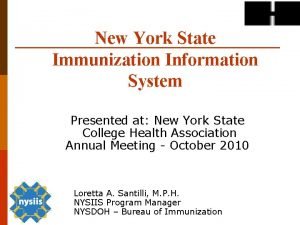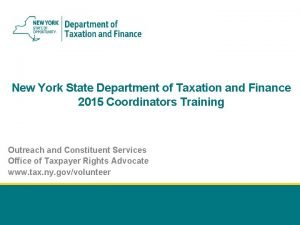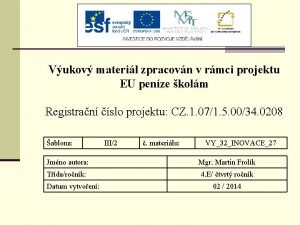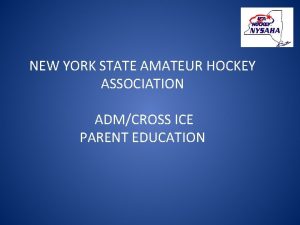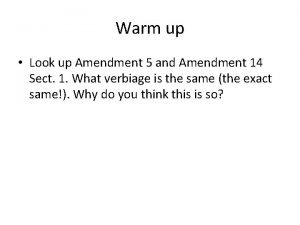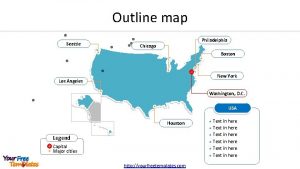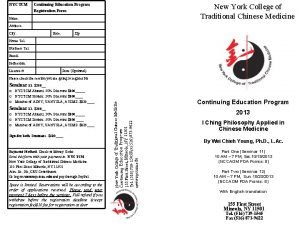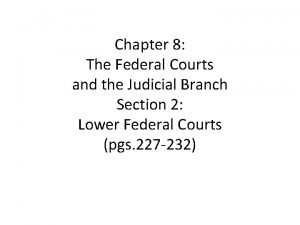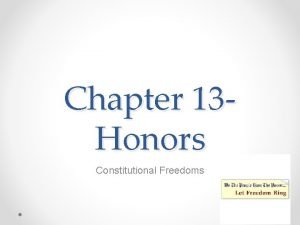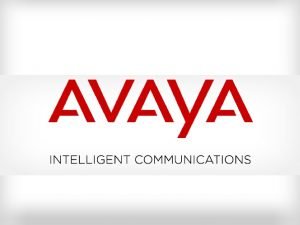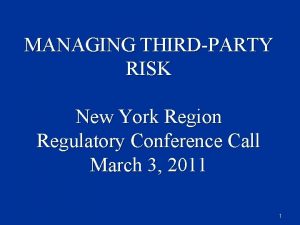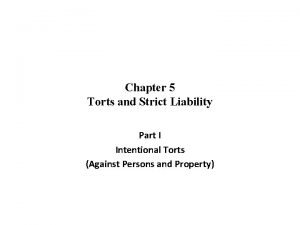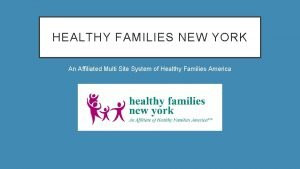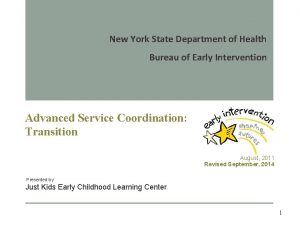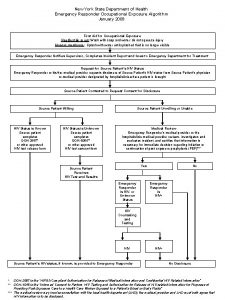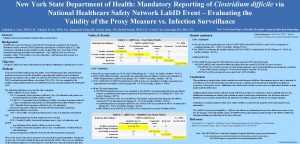New York State Department of Health Division of































































































- Slides: 95

New York State Department of Health Division of Family Health Bureau of Early Intervention Program Records September, 2012

Unit 1: Welcome, Introductions and Course Overview 2

Agenda Unit 1: Welcome, Introduction and Course Overview Unit 2: Background and Legal Requirements Unit 3: Content of Records Unit 4: General Billing and Claiming Information Unit 5: Electronic Records and Signatures BREAK Unit 6: Procedural Safeguards Unit 7: Record Retention Requirements Unit 8: Wrap Up and Course Evaluation 3

Learning Objectives • Identify and reference the various laws and regulations that govern the documentation, retention and retrieval of Early Intervention records. • Apply your understanding of the general requirements for Early Intervention record documentation, retention and retrieval to your role in the Early Intervention Program. 4

Unit 2: Background and Legal Requirements 5

What is the Purpose of Keeping Records? • Document compliance of municipalities and providers relative to laws and regulations. • Support payment for services. • Document EI clinical activities for parental review and possible amendment. 6

Regulatory Definition of “Record” “. . . any information recorded in any way, maintained by an Early Intervention Official, designee, or approved evaluator, service provider or service coordinator. A record shall include any file, evaluation, report, study, letter, telegram, minutes of meetings, memorandum, summary, interoffice or intraoffice communication, memorandum reflecting an oral conversation, a handwritten or other note, chart, graph, data sheet, film, videotape, slide, sound recording, disc, tape and information stored in microfilm or microfiche or in computer readable form. ” 10 NYCRR § 69 -4. 1(al) 7

What is a Record? To summarize: • Any information recorded in any way maintained by EIO, designee, evaluator, service provider, or service coordinator. • All information/documents pertaining to Mediation or Impartial Hearing. 8

Recommendations for Maintaining Records • Coordinate record keeping systems. • Conduct periodic review of provider documentation at the provider’s site. • Use a chronological filing system to facilitate monitoring and audits. • Use a list or tracking form to document significant dates/events. 9

Legal Requirements EI Records are subject to the following: • Federal Family Educational Rights and Privacy Act (FERPA) l 34 CFR Part 99 • Individuals with Disabilities Education Improvement Act (IDEA) 2004 l 34 CFR Parts 300 and 303 10

Legal Requirements (cont’d. ) • Title II-A of Article 25 Public Health Law • 10 NYCRR Section 69 -4 (EIP Regulations) • Medicaid Program • 18 NYCRR Parts 360 and 500 -541 Medical Assistance Program (Medicaid) 11

FERPA Protects the privacy of: • Student education records. • Student special education records under IDEA 2004. • Early Intervention records under Part C of IDEA 2004. 12

FERPA (cont’d. ) Child Records • There is no specific provision in FERPA or IDEA that requires creation of a single record. • Some EI records include information about more than one child/family. 13

FERPA and IDEA: Parental Rights Parental rights found in FERPA and IDEA are incorporated into EIP Regulations at NYCRR 694. 17(c), and apply to: l Evaluations and assessments. l Eligibility determinations. l Development and implementation of IFSPs. l Individual complaints dealing with the child. l Any other area under the Early Intervention Program involving records about the child and the child’s family. 14

Medicaid and EI • All EI services are included in the State Medicaid Plan and are reimbursed by Medicaid for children enrolled in Medicaid. • All EI providers must complete a Medicaid provider agreement. • All EI agencies* are required to enroll as Medicaid providers. (10 NYCRR 69 -4. 5(a)(1)) *This does not currently apply to individual providers and individual providers operating with agency names. • Municipalities are Medicaid providers for the purpose of billing Medicaid. New requirements regarding billing of EI services go into effect in 2013. Further guidance will be provided at a later date. 15

Medicaid Requirements • Medicaid requires that providers of service prepare and maintain contemporaneous records that demonstrate the provider’s right to receive Medicaid payments. • Medicaid requirements, including those pertaining to the content and retention of records, must be adhered to for all children receiving services under the Early Intervention Program. 16

Current Public Health Law Requirements • Municipalities must seek reimbursement in the first instance from third party payors, including Medicaid, prior to seeking reimbursement from the State for its share of costs associated with early intervention services. • EI providers must submit adequate and complete information necessary to support municipal billing of third party payors and Medicaid. New requirements go into effect in 2013. Further guidance will be provided at a later date. 17

Responsible Parties Who is responsible for maintaining and protecting Early Intervention records? • Municipal agencies responsible for the local administration of EI Program. • Agency providers of EI services. • Individual providers of EI services. 18

Responsible Parties (cont’d. ) • Municipal or Agency contractors: l Rendering provider of service should retain complete and original records. • Municipal or Agency employees: l Municipality or Agency retains records. New requirements go into effect in 2013 regarding municipal and agency provider contracts 19

Record Retention and NYEIS ¡ NYEIS serves as a data system and does not replace paper record keeping requirements or change the regulatory record keeping responsibilities of early intervention providers. ¡ In addition to the information entered and stored in NYEIS, providers must continue to maintain a “hard” copy of the child’s record containing all the necessary documentation identified in regulation. (10 NYCRR 69 -4. 26) 20

Unit 3: Content of Records 10 NYCRR 69 -4. 26 21

Municipal Record Retention Responsibilities • Intake and referral documents. • Medicaid and third party payor information, including the date the information was obtained and updated OR a copy of Parent Declination to Provide Insurance Information. • Parent signature documenting receipt of EIP rights. • Copies of all required written notices to the parent. 22

Municipal Record Retention Responsibilities (cont’d. ) • All original consent forms signed and dated by the parent. • Designation of the initial service coordinator. • Designation of a surrogate parent when necessary. • Evaluation and diagnostic reports. • All documentation relating to the creation, review, and amendment of an IFSP. * * NYEIS does not contain all regulatory requirements for an IFSP. Certain components must be maintained as a paper copy. 23

Municipal Record Retention Responsibilities (cont’d. ) • All correspondence to/from the municipality regarding the child and family. • Notations of any relevant discussions with parents, providers and others. • Correspondence with the Commissioner of local social services districts, or their designee. • Documentation on due process proceedings. • Correspondence with local school districts regarding a child’s transition and notations of all actions taken to ensure a smooth 24 transition.

Municipal Record Retention Responsibilities (cont’d. ) • Reasons for a municipality’s decision to close a child’s case. • Documentation to support municipal claims to third party payors, Medicaid, and the State. • Any other documentation that relates to a child’s participation in the program. New requirements go into effect in 2013 regarding municipal transition and billing/claiming activities. 25

Agency and Individual Provider Responsibilities • Documentation of written correspondence with or regarding the child/family. • Documentation of any relevant discussions with parents, other providers, or municipalities regarding a child/family. • Signed parental consents relevant to delivery of services. • Signed parental consents related to the disclosure and/or exchange of information with other parties. • Copies of any written notice(s) sent to the parent by the provider. 26

Agency and Individual Provider Responsibilities (cont’d. ) • All IFSPs and related documentation. * • Authorizations to provide services. • Documentation of accidents or incidents. • Original signed and dated session notes. • Periodic progress notes. • Written orders or recommendations for services. * NYEIS does not contain all regulatory requirements for an IFSP. Certain components must be maintained as a paper copy. 27

Agency and Individual Provider Responsibilities (cont’d. ) • All reports pertaining to the child and family, including evaluations, ongoing assessments, and any professional or medical reports transmitted to the provider with parental consent. • Correspondence regarding discontinued services, when applicable. • Billing documentation. • Any other documentation relevant to services rendered to a child and family participating in the EIP. 28

Written Orders (Scripts) and Recommendations • Written orders or recommendations must be obtained for physical therapy, occupational therapy, nursing services, and speech-language pathology services. • New State Education Law effective February 13, 2012, changes who can provide written orders for occupational therapy services. 29

Who Can Provide Written Orders and Recommendations? • Written Order for Physical Therapy: Physician, Physician’s Assistant, or Nurse Practitioner • Written Order for Occupational Therapy: Physician, Physician’s Assistant, or Nurse Practitioner • Written Order for Nursing Services: Physician, Physician’s Assistant, or Nurse Practitioner • Recommendation for Speech-Language Services: Physician, Physician’s Assistant, Nurse Practitioner, or Speech-Language Pathologist 30

Written Orders and Recommendations • Written orders or recommendations must be obtained by the provider of the service before the service can begin, and are maintained in the child’s record. • Original written orders and recommendations should be maintained by the rendering provider. • Faxed copies of written orders are acceptable if they are appropriately signed and legible. 31

What are the Medicaid Requirements for Orders/Scripts? • The name of the child for whom the order is written; • The complete date the order was written and signed; • The service that is being ordered; • Provider’s contact information (office stamp or preprinted address and telephone number); • Signature of a NYS licensed and registered physician, a physician assistant, or a licensed nurse practitioner acting within his or her scope of practice; • The time period for which services are being ordered. • The ordering practitioner’s National Provider Identifier (NPI) or license number; and, • Patient diagnosis and/or reason/need for ordered services (ICD code). 32

Session Notes • Are completed by all qualified personnel for each service delivered. • Document the time and date that services were delivered. • Assist payors, parents, providers and municipalities in assessing the effectiveness of the IFSP outcomes. • Must be created contemporaneously. 33

Session Notes (cont’d. ) • While it is appropriate for a provider to record the child's responses elicited during therapy to assist with accuracy of recall, it is expected that actual documentation of the outcome of the treatment in the required session note will be done immediately after the completion of the direct contact with the child and family. 34

Session Notes (cont’d. ) Must include: • Child’s name. • Date of service provided. • Type of service provided • The time the service began and the time it ended. • Brief description of the child’s progress made by receiving the service during the session as related to outcomes contained in the IFSP. 35

Session Notes (cont’d. ) Must include (cont’d. ): • Name, title and signature of the person delivering the service. • Date the session note was created. • Signature of the parent or caregiver. 36

Periodic Progress Notes • Created to summarize the • Effectiveness of services. • Progress made toward major goals/ outcomes. • Prepared by all providers • Timeframe • Minimum: at six months and annually. • Recommended: every 90 days. 37

Service Coordination Notes “Agency and individual providers of initial and/or ongoing service coordination services shall document all activities related to the performance of their duties as set forth in sections 69 -4. 6 and 69 -4. 7 of this subpart. . . ” 10 NYCRR 69 -4. 26(d) 38

Service Coordination Notes Must including the following information: l Child’s name. l Date of service. l Description of activity. l Start and end time for each activity. l Name, date and purpose for contacting providers or others on behalf of the child/family. l Name and signature of the Service Coordinator, with the title “Initial Service Coordinator” or “Ongoing Service Coordinator” as appropriate. 39

NYEIS and Child Records Currently, NYEIS does not affect the responsibility of Early Intervention Program providers regarding record-keeping. Providers must continue to maintain a “hard” copy of the child’s record containing all the necessary documentation, as identified in EIP regulation 69 -4. 26. 40

Unit 4: General Billing and Claiming Information 41

ICD Codes • The International Classification of Diseases coding system classifies diseases/diagnoses and a wide range of signs, symptoms, abnormal findings, and external causes of injury or disease. • ICD diagnosis codes are typically assigned by a physician familiar with the child. • For children referred to the EIP with a diagnosis, the MDE team must confirm and report the diagnosis in the evaluation report and summary. 42

ICD Codes • Providers should use the ICD codes that were included as part of the MDE on which the child's eligibility for the EIP was established on their claims. • Providers may, in addition to the ICD code that established the child's eligibility for the EIP, choose to include an additional ICD code(s) that more specifically describes why treatment was provided. 43

Healthcare Common Procedure Coding System (HCPCS) • HCPCS Level I: • Contains Current Procedural Terminology (CPT) codes used to describe all medical procedures and services. • Medicaid requires HCPCS/CPT codes to be reported on all claims for services, including services performed by a special educator. 44

Healthcare Common Procedure Coding System (HCPCS) • HCPCS Level II: • Alpha-numeric coding system • Identifies products, supplies and services not included in CPT codes: • ambulance services • durable medical equipment, prosthetics, orthotics, and supplies 45

HCPCS and Special Educators • HCPCS/CPT codes must be provided in NYEIS for the following services provided by a special educator: • supplemental evaluations • family training • parent-child group • group developmental interventions • vision • HCPCS/CPT codes for special instruction services by a special educator can be entered in NYEIS and are recommended. 46

National Provider Identifier (NPI) • The federal Health Insurance Portability and Accountability Act (HIPAA) version 5010 requires all EIP providers, including licensed professionals and those who are not licensed but are otherwise qualified to deliver services, to obtain an NPI number. • This includes service coordinators and special educators. 47

Unit 5: Electronic Records and Signatures 48

Electronic Records and Signatures • Electronic records/signatures and scanned documents are permissible if the electronic/scanned records meet Medicaid standards for audit. 49

Medicaid Standards for Electronic Records • Does the record itself meet the general and specific requirements of the regulations as to content? • Is it possible to determine when the record was created? • Is there a process to prevent records from being altered after they are created? • If records can be altered, is the alteration process documented? • Is the actual caregiver identified in the record? 50

Medicaid Standards for Electronic Records (cont’d. ) • If entries are menu driven, are they appropriate to the service provided and is the caregiver identified as having selected the entry? • Has the provider set up a system of internal controls that insures that actual completed service delivery drives Medicaid billing? • Are the records accessible? Records should be maintained in the ordinary course of business so that no “special” programming, software, language, etc. , is required to access them. 51

Break 52

Unit 6: Procedural Safeguards 53

Procedural Safeguards We will discuss: • Confidentiality • Access to Records • Amending the Record • Faxed Information, Use of E-mail, and Storage Facilities 54

Confidentiality Requirements Municipalities, Providers, Evaluators, Service Coordinators, and/or Personnel Involved in Mediation or Impartial Hearings: • cannot disclose personally identifiable data, information, or records pertaining to an eligible child to anyone other than the parent, except in accordance with certain provisions of federal laws and regulations. • under FERPA, 34 CFR § 99. 31, early intervention records may be disclosed without parental consent when the disclosure is pursuant to a lawfully issued court order or subpoena. 55

Confidentiality Requirements (cont’d. ) • must adopt policies and procedures to preserve the confidentiality of personally identifiable information • must document access to a child’s early intervention record • must designate an individual responsible for ensuring the confidentiality of personally identifiable information • must ensure a secure location for maintaining records containing personally identifiable information, including records that travel with a provider to deliver services 56

Confidentiality Requirements (cont’d. ) • must maintain a record of any individual accessing a record, including the purpose for which the record was accessed • must assure that all employees, contractors, consultants, and volunteers are informed about and are required to adhere to the confidentiality policies and procedures. • must adhere to all legal requirements that protect early intervention records containing sensitive information (such as sexual or physical abuse, HIV status, treatment for mental illness, the child’s parentage, etc. ). 57

Confidentiality (cont’d. ) Early Intervention Officials are further required to: • establish policies and procedures that ensure the confidential exchange of information among parents, providers, and the municipality • make reasonable efforts to notify parents when maintenance of personally identifiable information is no longer necessary in the EIP 58

What is Personally Identifiable Information? Personally identifiable information for a child, parent or other family member includes: • Name • Address • Personal identifier such as Social Security number • Personal characteristics 59

Disclosure • The EIO is responsible for ensuring the confidential exchange of information between the parent, evaluators, service provider, and service coordinators. • The EIO is also responsible to have policies and procedures in place that allow the parent to give voluntary written consent for the release of information. • Parental consent is not required for anyone acting in an oversight or monitoring capacity to access child records (i. e. , IPRO). 60

Disclosure (cont’d. ) There may be instances when individuals other than the parent, evaluator, service provider, service coordinator or authorized federal, state and municipal employee directly involved with the child have authorization to access a child’s record. In these instances, the EIO, service provider, and/or service coordinator must keep a record of: • name of the individual accessing the record • date of access • purpose for which the party is authorized to access the record 61

Types of Consent Parents give voluntary consent for the exchange or release of information by signing a General or Selective Release and the EIO must provide the parent with: • Information about their right to refuse a general release. • The opportunity to sign a selective release. • The opportunity to revoke a general or selective release at any time. 62

Types of Consent (cont’d. ) General Release: • Allows for the confidential exchange of information among members of the IFSP team, including parents, evaluators, service providers and service coordinators, involved in the ongoing provision of services to the child. • Parents should be informed about the scope of information that can be shared under a general release. 63

Types of Consent (cont’d. ) Selective Release Specifies: • Who can access the records. • What information can be released and to whom. • The time period for which consent is applicable. 64

Selective Release: FERPA Required Elements • Names of both entities involved in the releasing and obtaining of information. • Which records will be obtained or released. • The specific record(s) to be used. • The purpose of such use. • The date the parent signed the consent. • The parent's signature and relationship to the child. 65

Sensitive and Extraneous Information • This is information about the child and/or family that is sensitive in nature and may not directly relate to the EIP. For example, a Child Protective Services report or HIV status. • Best Practice Recommendation: Sensitive information should be kept in a separate location from the child’s record and service coordination notes. There should be a system in place to indicate that a separate file exists. 66

Sensitive and Extraneous Information (cont’d. ) • Providers must adhere to the confidentiality requirements of the EIP, including all legal requirements that protect records containing sensitive information. • When consent is given by a parent or guardian to release information, only the information appropriate to the request should be released. • Sensitive information about the child and family should not be release and must be protected. 67

Parental Access • EIOs and EI providers must ensure parental access to their child’s record, unless the parent is prohibited by State or Federal Law (e. g. , custody issues). • If there are multiple entries, parents must be provided access to information that is specific only to their child. 68

Parental Access (cont’d. ) Parental rights in reviewing/inspecting records: • Information must be understandable and available upon request. • Obtain a copy of any EI record within 10 working days of receipt of the request. • Obtain a copy of any EI record within 5 working days for mediation or impartial hearing. • A representative may review an EI record on the parents’ behalf. 69

Parental Access (cont’d. ) EIOS and Early Intervention providers: • May charge parents a reasonable fee to copy records, unless the fee is a barrier to inspection and review. • May not charge parents a fee for records related to evaluations and assessments. • May not charge parents a fee for search and retrieval of records. • Must maintain a record of all parties requesting access. 70

Parental Access: Children in Foster Care • Parental rights extend to Commissioners of Social Services for children in the care and custody or custody and guardianship of the local social services districts. 71

Amending the Record EIOs and EI providers: • Ensure parental right to object to or request amendments to the contents of EI records. • Inform parents regarding procedures to amend the record. • Respond to requests to amend the record within 10 working days. 72

Agreement to Amend Record • Provider notifies the parent and service coordinator of the agreement to amend the record. • Service coordinator amends the record and notifies the parent that the amendment has been made. 73

No Agreement to Amend Record • EI provider must notify the EIO of the decision. • EIO must: • Notify parent in writing of decision not to amend. • Inform parent of the right to an administrative hearing. 74

No Agreement to Amend Record (cont’d. ) If a parent requests an administrative hearing, the EIO must: • Convene an administrative hearing within a reasonable amount of time. • Adhere to the requirements for such a hearing [EI regulation: 69 -4. 17(4)]. • Order any amendment the municipality determines appropriate. 75

No Agreement to Amend Record (cont’d. ) • Notify all appropriate parties of the ordered amendment. • Notify parents when a requested amendment is not ordered. • Inform parents of their right to include a statement reflective of their views that will be maintained and disseminated as part of the record. 76

Use of E-Mail In order to use e-mail to transmit personally identifiable information, providers must ensure confidentiality by using: • password protection • firewall software • encryption 77

Use of E-Mail If a parent requests that providers transmit personally identifiable information to them at an unsecure e -mail address, the parent must provide written, informed consent authorizing this manner of transmission. 78

Faxed Information • Fax cover sheets must contain a confidentiality statement. • Providers must ensure that fax recipients maintain a secure site where faxed information would not be accessible to unauthorized personnel or to the general public. 79

Use of a Storage Facility A fully-executed contract must contain: • A statement about the purpose of the contract. • Names of the provider and the contractor (storage facility). • Signatures of the provider and the contractor. • Lien Law language stating that the contractor may not sell the contents in storage. In case of default, the contractor may over-lock the storage facility and deny the provider access. • A statement that the contractor will dispose of records in a confidential manner (shredding, incineration) should the default not be resolved. 80

Unit 7: Record Retention Requirements 81

Individual Providers • Individual early intervention providers must maintain records for a minimum of 6 years following the date of payment in order to meet Medicaid requirements. 82

Individual Providers and State Education Law • In addition to the minimum of 6 years, individual early intervention providers who are licensed, registered, or certified under state education law must retain records in accordance with the laws and regulations that apply to their profession. 83

Provider Agencies • When an agency provider employs individual therapists to provide services, the agency provider should maintain the record. • When an agency provider contracts with individual providers to provide such services, the rendering provider under contract should maintain the record. • Contracts between agencies and contracted providers should specifically address record retention and the confidentiality of such documents. When implemented in 2013, the changes in Public Health Law will affect the information on this slide regarding municipal contracts with providers. 84

Provider Agencies (cont’d. ) • EI providers/agencies should work closely with the municipality they are under contract with regarding the disposal of records. • Contracts may contain additional requirements or time periods under which records are governed. • Local laws or record keeping requirements may apply. When implemented in 2013, the changes in Public Health Law will affect the information on this slide. 85

Municipalities • All municipalities, except NYC, are subject to the Local Government Records Law. • EI records are not exempt from the requirements under this law. 86

Local Government Records Law Requirements for Municipalities • Retention of the individual case record: • until age 21 • Retention of screening, assessment, and referral records not found in the individual case record: • 7 years 87

New York City • NYC is not subject to the Local Government Records Law. • NYC public agencies are subject to the requirements of the Department of Records and Information Services (DORIS) and of FERPA, IDEA, PHL, and Medicaid. • To date, DORIS has issued no record retention requirements in addition to what is already required under FERPA, IDEA, PHL, and Medicaid. 88

Billing Records • Medicaid requires billing records to be maintained for 6 years following the date of payment. • There is nothing to prohibit a municipality from requiring a longer retention period. 89

Destruction of EI Records All municipalities, including NYC, must make reasonable efforts to ensure notification of the parent when maintenance of personally identifiable information is no longer necessary for educational purposes. l At the request of the parent, EIO shall ensure all personally identifiable information is removed from the record and destroyed. l A permanent record of the child and family’s name, address, services and dates of service may be maintained without time limits. NYCRR 69 -4. 17 (c) 90

Unit 8: Wrap-up and Course Evaluation 91

Questions. . . 92

Wrap-Up Helpful Resources 93

Wrap-Up Course Evaluation 94

Early Intervention Program Records Thank you and have a safe trip home! Please visit these web sites: www. health. ny. gov/community/infants_children/early_intervention/ www. eilearningnetwork. com 95
 How many roundabouts in new york
How many roundabouts in new york Nys division of criminal justice services
Nys division of criminal justice services New york city department of youth and community development
New york city department of youth and community development Nys npa
Nys npa New york tap application
New york tap application New york state teacher certification examinations
New york state teacher certification examinations New york state learning standards science
New york state learning standards science State test 2018
State test 2018 Nerfc
Nerfc New york state vegetable
New york state vegetable Gigp 30
Gigp 30 New york state professional firefighters association
New york state professional firefighters association What is nysiis
What is nysiis New york state association of transportation engineers
New york state association of transportation engineers New york state industries
New york state industries Nysrc
Nysrc New york tax practitioner hotline
New york tax practitioner hotline Nysbon
Nysbon New york state fish
New york state fish New york state nickname
New york state nickname New york state medicaid prior authorization
New york state medicaid prior authorization New york state amateur hockey association
New york state amateur hockey association New york state county highway superintendents association
New york state county highway superintendents association New york, new jersey, pennsylvania, and delaware
New york, new jersey, pennsylvania, and delaware Marquee new hartford
Marquee new hartford Articles of confederation characteristics
Articles of confederation characteristics Leanne keene french ambassador arrives from paris
Leanne keene french ambassador arrives from paris New york counseling association
New york counseling association Washington state department of social and health services
Washington state department of social and health services Ldh health standards
Ldh health standards Business etiquette in new york
Business etiquette in new york Procedural vs substantive due process
Procedural vs substantive due process Merriweather library buffalo new york
Merriweather library buffalo new york Map of west and east egg
Map of west and east egg Dry cow candy
Dry cow candy Taoki à new york
Taoki à new york Boston new york map
Boston new york map New york kurosu
New york kurosu Ny college of traditional chinese medicine
Ny college of traditional chinese medicine New york times upfront
New york times upfront Ccta new york
Ccta new york Lega amerike
Lega amerike New york harm reduction educators
New york harm reduction educators Distretti new york
Distretti new york Harlem new york in the 1920s
Harlem new york in the 1920s New york certified midwife
New york certified midwife Leotrace
Leotrace Hunger in new york city poem
Hunger in new york city poem New york scale heart failure
New york scale heart failure Map of west and east egg
Map of west and east egg New york oceanic
New york oceanic Ellis island inspections
Ellis island inspections New york 7
New york 7 New york hf classification
New york hf classification Federal district court map new york
Federal district court map new york Gitlow v new york constitutional question
Gitlow v new york constitutional question New york avaya
New york avaya New york school
New york school My dad (fly just) from new york
My dad (fly just) from new york New york kerületei
New york kerületei New york school poets
New york school poets New york statewide senior action council
New york statewide senior action council Why is new york city called the big apple
Why is new york city called the big apple New york campus compact
New york campus compact New york city technology forum
New york city technology forum Third party risk management conference 2019 new york
Third party risk management conference 2019 new york Cnms nysed
Cnms nysed Rena abbasova new york
Rena abbasova new york New york
New york New york times v. sullivan
New york times v. sullivan 13 colonies brainpop
13 colonies brainpop Which
Which What is kindergarten curriculum night
What is kindergarten curriculum night Fraudulent syn
Fraudulent syn Rabbit island new york
Rabbit island new york The new york weekly journal
The new york weekly journal The standard
The standard How many colors do you see
How many colors do you see En quoi new york est une ville mondiale
En quoi new york est une ville mondiale The new york weekly journal
The new york weekly journal 32 000 troops in new york harbor
32 000 troops in new york harbor Curtis lumber perth ny
Curtis lumber perth ny New england colonies brochure
New england colonies brochure By the waters of babylon stephen vincent benet
By the waters of babylon stephen vincent benet Blackout poem summary
Blackout poem summary Sindesmofit
Sindesmofit New york stereotypes
New york stereotypes Emerald hotel thassos
Emerald hotel thassos Solar panel efficieny
Solar panel efficieny 160 5th avenue
160 5th avenue Karsten moran for the new york times
Karsten moran for the new york times Club med near me
Club med near me New york roundabout
New york roundabout New york medical college interview
New york medical college interview New york broj stanovnika
New york broj stanovnika Healthy families new york
Healthy families new york












